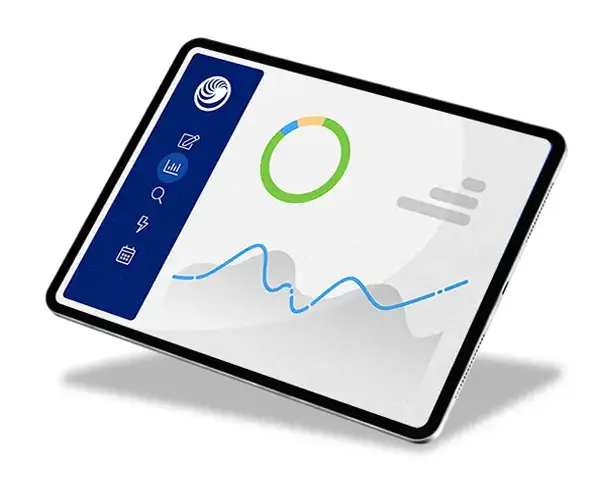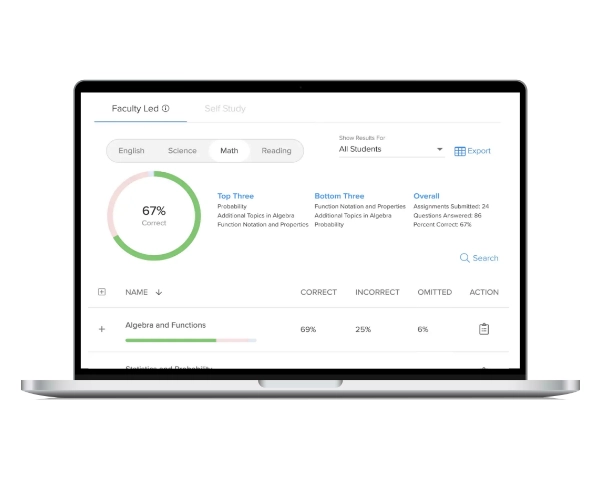Utilizing data to guide classroom instruction benefits all students. But it's especially important in Advanced Placement® classrooms, where the coursework is more rigorous and the student count may be higher. Data can quickly help teachers identify their students' strengths and weaknesses, personalize learning, set goals for improvement, and track progress over time.
Types of Data to Track
Many types of data can assist in creating and adjusting instruction.
Student Performance: Student performance is one of the most beneficial and dynamic forms. Progress checks and unit exams can help teachers monitor their students' progress consistently throughout the year. UWorld's AP question bank is an effective tool for quickly assessing student performance and leveraging analytics to efficiently monitor progress and make necessary adjustments to your instruction.
A common misconception is that student progress is evident solely through grades in the gradebook; however, this is not always the case. Nowadays, we see more students not turning in work or submitting it at the last minute. This skews grades, making them an inaccurate representation of students' knowledge and abilities. Therefore, informal assessments, such as quick writes, self-evaluations, and exit tickets, are also valuable for consistently monitoring student progress.

Demographic and Background: Another type of data that is often overlooked is demographic and background data. Utilizing the demographic data of your students can help promote equity and inclusion in lessons. By selecting texts that are relevant and engaging, you can foster more culturally responsive instruction. Teachers can also leverage demographic data to tailor support and instruction for specific groups of students, helping to identify and close achievement gaps that might otherwise go unnoticed. Additionally, using students' background data, such as prior academic records and baseline skill levels, provides teachers with valuable insights into past achievements and helps set realistic and meaningful goals for future progress.
Behavioral and Engagement: Behavioral and engagement data is a vital yet under-utilized resource in data-driven instruction. Factors such as attendance patterns, participation rates, and homework completion rates are often overlooked by teachers, who may regard them as issues solely within students' control. However, these metrics can be instrumental in transforming instruction to better meet students' needs and enhance their understanding of the material being taught.
While AP courses follow a specific structure outlined in the CEDs provided by College Board®, teachers still have the flexibility to design creative and engaging lessons that align with the framework. By incorporating innovative teaching strategies, teachers can enhance student engagement and improve behavioral and participation data without compromising the rigor or objectives of the course. As a result of improved behavior and engagement, students are more likely to understand the material and learn and analyze at higher levels.
Using Data Effectively
One way to ensure effective and consistent use of data is to build a feedback loop into your planning process. This typically involves collecting student performance data, analyzing it, using it to adjust instruction, monitoring the impact, and repeating the process. By creating this feedback loop, teachers can identify gaps in understanding at the individual student and classroom levels, enabling them to determine what changes in lesson plans, teaching strategies, or supports need to be implemented to better assist students.
This data can also be useful in predicting student outcomes in future lessons, helping teachers adjust pacing and focus as needed. For example, if a class is consistently struggling with free-response questions (FRQs) or document-based questions (DBQs), the teacher may consider breaking down the process components before the next assessment.
Engaging students in their growth is another effective way for educators to support student success. As teachers, it is our responsibility to ensure that students understand the skills and concepts they need to master and how they can improve their knowledge and productivity. One way we can achieve this is by guiding them in setting and adjusting SMART goals based on their progress data.
For those unfamiliar with the term, SMART stands for Specific, Measurable, Achievable, Relevant, and Time-bound. By walking students through the process of setting and refining these goals throughout the year, we provide them with the opportunity to assess their own progress. This level of self-assessment encourages students to take accountability for their own learning, helping them identify techniques and strategies they can use independently to advance their knowledge. Additionally, this process fosters confidence in their abilities and prepares them for further success beyond high school.

Encouraging a Growth Mindset With Data
The final piece of the puzzle that many teachers overlook is shifting the classroom culture to focus on a growth mindset. As educators, we need to help students value their progress and achievements rather than merely pursuing letter or numerical grades. This shift in mindset transforms the way students approach their learning, fostering an emphasis on growth instead of fixating on the discouragement that often accompanies grades they have been conditioned to view as failures.
Celebrating successes, both individually and within the classroom as a whole, is an effective way to help shift this mindset. By highlighting small wins and incremental improvements, we encourage students to focus on these developments. Students can then reflect on how they have progressed in these areas and apply that understanding to other areas needing improvement. These small wins and improvements can be found in assessment data and a student's advancements in critical and creative thinking.
Creating an Environment for Data-Informed Decisions
Effectively using data to support student success in AP classrooms goes beyond just numbers and assessment scores. It is more important to create an environment where data informs decision-making, inspires teaching practices, and empowers students to aim higher.
By tracking various types of data, teachers can design lessons that are personalized, inclusive, and engaging. They can then leverage this data to create a feedback loop that promotes continuous improvement while encouraging students to take ownership of their learning through SMART goals.
Additionally, a shift in focus toward a growth mindset can help students view learning as a journey and take pride in their progress rather than becoming discouraged by pursuing perfection. By using data thoughtfully and creatively, we can unlock every student's potential for success.

Erin Nesbitt is an experienced educator currently teaching at Seguin High School in Arlington, Texas. While she is passionate about teaching English 4 and AP Literature and Composition, Erin has also instructed both on-level and advanced English 1, as well as English 3. She is committed to enhancing student engagement and learning outcomes through innovative, technology-integrated lessons. With a focus on fostering critical thinking and creativity, Erin strives to create an open and inclusive classroom environment that prepares students for future academic and professional success.





